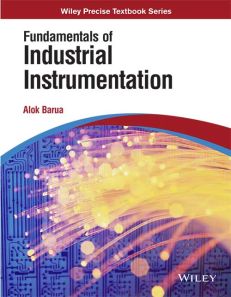Fundamentals of Industrial Instrumentation
ISBN: 9788126528820
344 pages
eBook also available for institutional users
For more information write to us at: acadmktg@wiley.com

Description
This textbook introduces Instrumentation devices in a way sufficiently complete so that the reader acquires an ability to make meaningful measurement of three important process parameters - temperature, pressure, flow - as well as other mechanical and chemical parameters. The book offers a comprehensive coverage of instrumentation and its practical implementation with an excellent balance of theoretical concepts and engineering practice. Any instrumentation system is incomplete without signal conditioning circuits and for this purpose one full chapter is devoted to various signal conditioning circuits. The book is designed for a one-semester course in Industrial Instrumentation or Instrumentation Devices.
Chapter 1: Introduction
1.1 Introduction
1.2 Process Instrumentation System
1.3 Instrument Characteristics
Chapter 2: Dynamic Characteristics
Learning Objectives
2.1 Introduction
2.2 Zero-Order Instrument
2.3 First-Order Instrument
2.4 Second-Order System
Problems
Chapter 3: Strain, Load, and Torque Measurement
Learning Objectives
3.1 Introduction
3.2 Strain Gauge
3.3 Load Cell
3.4 Cantilever Beam Type Load Cell
3.5 Intelligent Load Cells
3.6 Torque Measurement
Problem
Chapter 4: Temperature Sensors
Learning Objectives
4.1 Introduction
4.2 Thermistor
4.3 Thermocouple
4.4 Resistance Thermometer
Problems
Chapter 5: Displacement Measurement
Learning Objectives
5.1 Introduction
5.2 Potentiometer
5.3 Linear Variable Differential Transformer (LVDT)
5.4 Capacitive Transducers
Problems
Chapter 6: Pressure Sensors
Learning Objectives
6.1 Introduction
6.2 Bourdon Gauge
6.3 Bellow Gauge
6.4 Diaphragm Pressure Transducer
6.5 Low Pressure Measurement
Problems
Chapter 7: Flowmeter
Learning Objectives
7.1 Introduction
7.2 Differential Pressure Flowmeters
7.3 Orifice Meter
7.4 Flow Nozzle/Dall Tube/Venturi Meter
7.5 Pitot Tube
7.6 Elbow Meter
7.7 Rotameter
7.8 Weir
7.9 Variable Reluctance Tachogenerator
7.10 Turbine Flowmeter
7.11 Electromagnetic Flowmeter
7.12 Ultrasonic Flowmeter
7.13 Hot-Wire Anemometer
Problems
Chapter 8: Flapper-Nozzle System
Learning Objectives
8.1 Introduction
8.2 Application as a Displacement Measuring Device
8.3 Static Sensitivity
8.4 Force Balance Differential Pressure Transmitter
8.5 Flapper Nozzle with Air Relay
8.6 Current-to-Pressure (I/P) Transducer
Chapter 9: Signal Conditioning Circuits
Learning Objectives
9.1 Active Filters
9.2 Single Amplifier Filter
9.3 Negative Feedback Circuits
9.4 Inductors Simulator
9.5 Low-Pass Filter
9.6 High-Pass Filter
9.7 Band-Pass Filter
9.8 State Variable Filter
9.9 Sample-and-Hold Circuit
9.10 Logarithmic Amplifier
9.11 Antilogarithmic Amplifier
9.12 Analog Switch
9.13 Analog Multiplexer and Demultiplexer
Chapter 10: Piezoelectric Sensors
Learning Objectives
10.1 Introduction
10.2 Piezoelectric Phenomenon
10.3 Piezoelectric Materials
10.4 Piezoelectric Transducers
10.5 Measuring Circuit
10.6 Piezoelectric Accelerometers
10.7 Unimorph
10.8 Bimorphs
10.9 Actuator Stacks
10.10 Sandwich Piezoelectric Transducers
10.11 Pyroelectricity
10.12 Limitations of Piezoelectric Materials
Chapter 11: Ultrasonic Sensors
Learning Objectives
11.1 Introduction
11.2 Analysis
11.3 Equivalent Circuit of the Transmitter
11.4 Transmission of Ultrasound
11.5 Measurement of Ultrasound
11.6 Special Application
Chapter 12: Measurement of Magnetic Field
Learning Objectives
12.1 Principle of Measurement of Magnetic Field
12.2 Hall Effect
Problems
Chapter 13: Optoelectronic Sensors
Learning Objectives
13.1 Photoconductivity
13.2 Photocurrent
13.3 The Semiconductor Photodiode
13.4 Sensors Based on Optical Fibre
Chapter 14: pH and Viscosity Measurement
Learning Objectives
14.1 Introduction to pH
14.2 Why is pH Measurement Important?
14.3 pH Probe
14.4 Measurement of Viscosity
Problem
Chapter 15: Dissolved Oxygen Sensors
Learning Objectives
15.1 Introduction
15.2 Dissolved Oxygen Sensing
15.3 Principle of Operation of Polarographic Electrode
15.4 Principle of Operation of Galvanic Electrode
15.5 Limitations of Single-Layer Electrode Model
15.6 Design of Electrodes
15.7 Details of Some Commercially Available DO2 Sensors
15.8 Electrode Metals
15.9 Electrolytes in DO2 Probe
15.10 Membrane
15.11 Signal Conditioning Circuits
15.12 General Design Considerations
15.13 Calibration of DO2 Sensors
Chapter 16: Gas Chromatography
Learning Objectives
16.1 Introduction
16.2 Different Methods in Chromatography
16.3 Basics of Chromatography
16.4 Liquid Chromatography
Chapter 17: Pollution Measurement
Learning Objectives
17.1 Introduction
17.2 Sample Collection
17.3 Aerosol Contaminants
17.4 Gaseous Contaminants
17.5 Carbon Monoxide Detection
17.6 NOx Measurement
17.7 Sulphur Dioxide Analyzer
17.8 Ozone Detection
17.9 Detection of Hydrocarbons
17.10 Air Quality Index
17.11 Measurement and Calculation
Chapter 18: Smart Sensors
Learning Objectives
18.1 Integrated, Smart, and Intelligent Sensors
18.2 Logical Function
18.3 Integration of Signal Processing
18.4 Self-Calibrating Micro Sensors
18.5 Self-Testing of Smart Sensors
18.6 Multisensing
18.7 Communication
18.8 Applications of Smart Sensors
Bibliography
Solutions to Problems
Objective Type Questions and Answers
Appendix I: Tables for Orifice Meter and Venturimeter
Appendix II: Thermocouple Tables
Index

